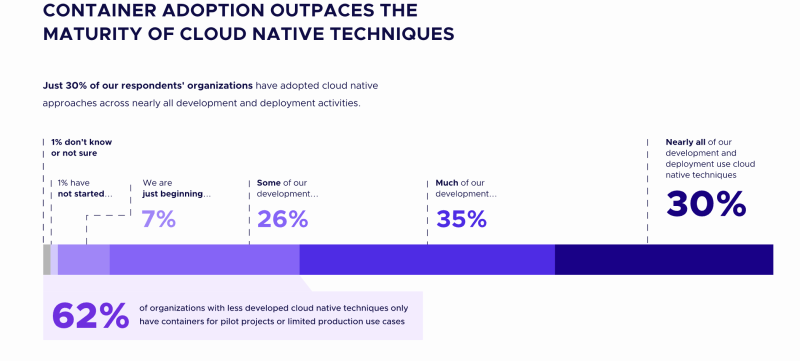In 2022, the Cloud Native Computing Foundation (CNCF) and Linux Foundation Research surveyed the cloud developer world. They found, to no surprise for anyone in the business, that cloud-native technologies are dominating the cloud application world.
The platform doesn't matter. Be it public, private, or hybrid clouds, it's becoming all cloud-native, all the time. These technologies, such as Kubernetes-orchestrated containers, service meshes, microservices, immutable infrastructure, and declarative APIs, are being used to create loosely coupled systems. These, in turn, are resilient, manageable, and observable. Thanks to higher-level technologies springing from this fertile soil, continuous integration/continuous delivery (CI/CD) has transformed how programs are built, patched, and delivered.
Specifically, the survey found that "Containers are the new normal." We've seen that coming, of course, since Docker charged into the scene in 2014. In fact, 44% of respondents reported already using containers for nearly all applications and business segments. It would be even higher, except companies report not enough training and security, according to CNCF.

In a separate study, "9 Insights on Real-World Container Usage," cloud-monitoring company Datadog, found that nearly half of all organizations using containers run Kubernetes to deploy and manage at least some of those containers. Personally, I find that a surprisingly small number. The vast majority of companies I cover use Kubernetes for container management and deployment.
As the CNCF also noted, however, "Kubernetes is emerging as the ‘operating system’ of the cloud." Kubernetes is used for running, well, almost anything and everything, today. And, according to Dynatrace's "Kubernetes in the Wild 2023 report," in 2021, in a typical Kubernetes cluster, application workloads accounted for most of the pods.
Kubernetes as glue
A year ago, it was different. Now, Kubernetes is used for auxiliary workloads (63%) over application workloads (37%). In practice, that means, organizations adopt Kubernetes for security controls, service meshes, messaging systems, and observability tools over end-user applications. Rather than being mostly used as a platform for end-user programs, Kubernetes is really becoming an operating system. In particular, Kubernetes' path forward as the glue for hybrid clouds is becoming clearer.
For all of Kubernetes and containers' adoption success, other cloud-native approaches are lagging. The CNCF found "just 30% of our respondents' organizations have adopted cloud-native approaches across nearly all development and deployment activities. Still, 62% of organizations that do not regularly use cloud-native techniques have containers for pilot projects or limited production use cases, indicating there is room for growth."
Web assembly rising
One cloud-native technology that is picking up is serverless architecture. In particular, WebAssembly use is rising. According to the survey, 37% of end-user organizations had some experience deploying applications with WebAssembly. The top WebAssembly runtimes are WasmEdge and WAMR.
Other technologies that see adoption rates leap forward include service mesh going from 27% in 2020 to 47% in 2022, and serverless architecture/function-as-a-service (FaaS), moving from 30% to 53%. There has also been a dramatic jump over the last year of service proxies being used within the CNCF community.
GitOps gets the love
The CNCF also found that organizations that have embraced cloud-native technologies beyond containers are likely to be embracing GitOps. GitOps implements CD for cloud-native applications. By using Git for declarative descriptions of the infrastructure currently desired in the production environment. Using these descriptions, the GitOps approach uses automated processes to make the production environment match the described state in the repository. Here, Argo and Flux are the major programs. Argo's adoption, in particular, has jumped from 10% to 28%.
Of course, it's not all rainbows and lollipops. Cloud-native developers are worried about security vulnerabilities and a lack of documentation. Mind you, all programmers everywhere are concerned with those. Their top concern, though, is a little more unusual. They fear their favorite cloud-native open-source project might become inactive.
True, Chris Aniszczyk, the CNCF's CTO, admitted, "We've archived a couple of projects in the past, like rkt, opentracing, etc." But, "We don't have particularly inactive projects in CNCF that would meet the bar to be archived currently. Of course, adopting sandbox projects is a bit riskier than graduated ones, and this is reflected in CNCF's project maturity process – graduated projects are very safe to bet on," he said.
Going forward, if you stick with more mature cloud-native programs for your cloud-development projects, all should be well. If you haven't started using cloud-native programs yet, it's high time you should. Tomorrow software will be built by today's cloud-native savvy developers.
Write to us and let us know if you are using cloud-native programs here.